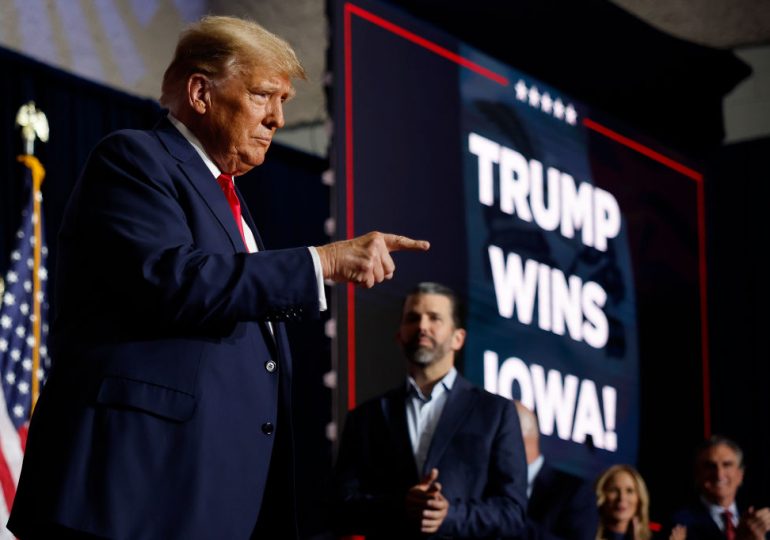This article is part of The D.C. Brief, TIME’s politics newsletter. Sign up here to get stories like this sent to your inbox.
As Nikki Haley raced to catch her overnight charter from Des Moines to Manchester, her team kept double-checking the numbers. The former South Carolina Governor and ex-Ambassador to the United Nations had posted a disappointing third-place finish in Iowa’s lead-off caucus on Monday, but the result doesn’t much alter the math that really matters: the chase for 1,215 delegates to the nominating convention in Milwaukee come July. As the wind raged outside their mini-motorcade, aides confirmed that the deflating results in Iowa had netted them seven of Iowa’s 40 delegates—just one fewer than won by silver medalist Ron DeSantis. Haley’s team was preparing for the long trek to New Hampshire’s North Country on Tuesday to show she was all-in on the Granite State.
[time-brightcove not-tgx=”true”]
For now Trump’s blowout victory shapes the narrative, as will the New Hampshire results on Jan. 23. But both are small prizes from a delegate perspective. Iowa offers less than 2% of the total delegates on the table for White House hopefuls. Polls show Haley has a shot at New Hampshire, which would, at least temporarily, end talk that the race is over as soon as it began. But New Hampshire offers just 22 seats on the convention floor. After that comes Nevada, whose 26 delegates, like Iowa and New Hampshire’s, are awarded proportionally; you get your share if you credibly show.
But that’s where the rules of the nominating contest grow increasingly friendly to the frontrunner. At Trump’s behest, Nevada Republicans passed a rule that blocks super PACs like the one doing a heavy lift for DeSantis’ day-to-day operations from being in the mix. The party also will now offer delegates through a caucus rather than a primary, a change seen as a favor to hardcore activists over casual voters. These were among the many insider-driven tweaks the Trump campaign has put in place nationwide as an insurance policy. (As of now, Haley isn’t even on the caucus ballot in order to show support for the party-run affair. She will instead appear on the symbolic primary ballot that offers no delegates.) Both New Hampshire and Nevada award delegates proportionally: New Hampshire has treats for candidates topping 10%, while Nevada has a threshold of 4%.
But starting with South Carolina and its 50 delegates, winner-take-all rules kick in. Second place in a lot of these early-nominating contests still amounts to First Loser. Idaho (March 2), Michigan (February 27 and March 2), and North Dakota (March 4) are all set up so the winner gets most of the delegates. In Idaho, for instance, any candidate getting above 50% gets the whole pot of 32 delegates. In Michigan, too, there are new party rules that set up a two-step process for picking up delegates; the change is widely seen as a pro-Trump move given his allies control the state political machinery and could summarily block rivals’ access to the process. Unlike eight years ago, Trump now has party insiders minding the stores to keep the process tilted in his favor.
Come Super Tuesday on March 5, things get even tougher for runners-up. Of the 15 states (plus American Samoa) having nominating contests that day, just two have plausible ways for non-winners to gain a meaningful number of delegates: Alaska and Colorado. (Of note: it’s not clear Trump will even be on Colorado’s ballot.) In others, there are provisions in state party rules that candidates topping 50% of the vote take home the lion’s share, setting up massive gains. For the first time, California’s 169 delegates will be awarded to the winner statewide and not by congressional district during a primary that leapfrogged ahead to offer a huge boost to its winner. Trump’s team was instrumental in this shift.
Running the table on Super Tuesday, when 874 delegates are on the table, can get a candidate 72% of the way to the total required for the nomination. Trump’s own internal projections have him in a position to win the nomination a week later.
The upshot is that the long-nurtured hopes of the Never Trump Republicans—defeat the former President by finally getting him one-on-one—doesn’t look like a recipe for success, if even it were possible. In a two-way race, the math just doesn’t work for the underdogs. The rules of the 2024 nominating contest are not meant to encourage also-rans from sticking around to pick up a delegate here or there. In 2016, the GOP watched as Trump slogged to the nomination with the likes of Ted Cruz nipping at him and threatening a delegate mutiny. Mitt Romney did the same four years earlier as a stubborn Rick Santorum kept peeling-off wins in states like Colorado and Tennessee. This time, the rules regime was meant to deliver Republicans a nominee as bloodlessly as possible. And they may work with admirable efficiency this year. The Iowa landslide led Trump to gently call on rivals to give up. But for now, the delegate race is anyone’s ballgame. Trump is up by 12 delegates over DeSantis and 13 over Haley. (Even fourth-place Iowa finisher Vivek Ramaswamy hobbled out of Iowa with three delegates—and an invitation to join Trump in New Hampshire for campaign stops this week as a dropout.) DeSantis framed a distant second-place in Iowa as a victory; Haley, despite coming in third, cast herself as the second half of a two-candidate race. But eventually, this narrative-shaping must give way to math, and the magic number of 1,215 has to be atop strategy sessions. And with the rules stacked in Trump’s favor as the primary goes on, it may not be long before both have hard choices to face.
Make sense of what matters in Washington. Sign up for the D.C. Brief newsletter.
Leave a comment








